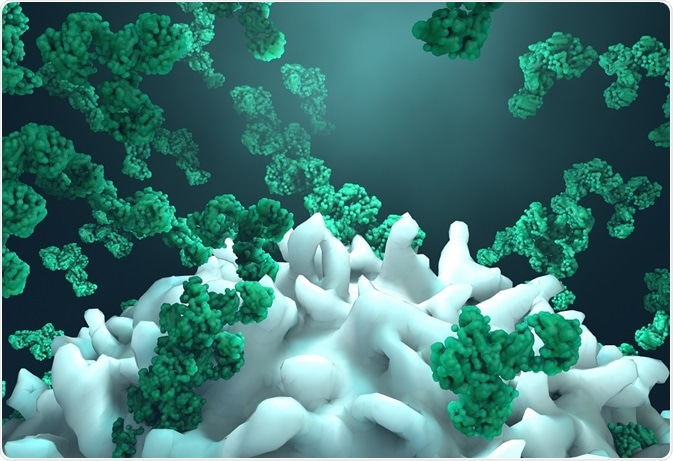Human blood samples can be used to produce antibodies against an antigen of interest. Since the blood contains antigen-presenting immune cells, antibody identification only requires a binding assay to identify the cells presenting suitable antibodies.
However, this selects for “early” antibodies, which in the organism would undergo maturation by multiple rounds of mutation and selection, leading to antibodies that are more effective in antigen-binding. Work by French researchers suggests that a CRISPR system can be used to drive an equivalent maturation process in vitro.
This research was published in the journal BMC Biotechnology.
 Image Credit: Design_Cells / Shutterstock.com
Image Credit: Design_Cells / Shutterstock.com
Antibody maturation in vivo
Antibodies hold great promise as therapeutic agents, and in fact, they are already in use for the treatment of a variety of diseases. As a great feature, antibodies for specific antigens can be isolated from human donors. For instance, the immune system of a person who was previously exposed to an antigen (e.g. from a viral or bacterial infection, or a vaccination) will attempt to identify an effective antibody that neutralizes the antigen.
Once a suitable antibody is found, it undergoes maturation cycles through which the antibody sequence will be optimized to increase its effectiveness in antigen binding. The resulting antibodies can be experimentally identified from blood samples by antigen binding assays, and if successful the antibody can be produced biotechnologically by established techniques.
To avoid that a human subject has to be exposed to an antigen, antibody-identification can also be carried out in cell cultures. In particular, antigen-presenting immune cells (B cells) can be isolated from human blood samples, and their antigen-specificity can be assessed in vitro, for instance by labeling antigens with fluorescent dyes and identifying which cells become fluorescent.
In this case, the antigen maturation cycles will have to be carried out in vitro too. Previous research has relied on the construction of large antibody mutant libraries with random mutations, which however required extensive screening to identify antibody mutants that had retained antigen-specificity but improved the strength of antigen-binding.
In this case study, French researchers led by Professors Richard Breathnach and Xavier Saulquin (Nantes) demonstrated that a CRISPR-X based approach can be used in vitro to induce mutations at specific sites of an antibody gene, improving its antigen-binding strength without compromising on antigen specificity.
CRISPR-controlled mutation windows
The scientists used immune cells form human blood donations to develop an antibody against an example antigen. For further studies, they selected an antibody that was not overly strong in binding the antigen. After isolation of the antibody-gene, they used genetic approaches to transfect a human cell line to produce the antibody.
Mutations were introduced into the antibody gene by using CRISPR-X. The conventional CRISPR gene editing system comprises a guide RNA (gRNA) for identification of a target DNA sequence, and an associated Cas9 enzyme that cleaves DNA at the site recognized by the gRNA.
With CRISP-X, however, a “dead” Cas9 variant is used which only binds to gRNA recognized site, and recruits additional enzymes that are capable of introducing DNA mutations in the surrounding of the binding site. Using this technique, the investigators generated antibody variants which were only mutated in certain gene regions, yet allowing considerable variability for gene editing.
In vitro “maturation” increases binding strength
With only two cycles of mutation and selection, the scientists were able to maturate their original antibody into a version with 80-fold stronger antigen-binding strength. Since they had carried out the procedure in in vitro cell cultures, these two mutation cycles only required six weeks of time.
Maybe the greatest opportunity of this method of antibody generation lies in the fact that the original antibody sequence came out of the immune system of a human donor, while maturation did not required the human organism.
For many antibody developments, antigens are injected into animals (e.g. mice) to use their immune system for antibody identification. The risk is that when injected into humans, the animal-derived antibody will resemble a foreign antigen and will be attacked by the human immune system. Starting out from human immune cells and maturating the antibodies in vitro may therefore improve the safety of antibodies for therapeutic use.
Conflicts of interest
The study authors declare in their publication that the sampling of blood from human subjects had been approved by the local ethics committee CPP Grand Ouest IV (reference number: MESR DC-2017-2987).
Source
Devilder MC et al., Ex vivo evolution of human antibodies by CRISPR-X: from a naive B cell repertoire to affinity matured antibodies. BMC Biotechnology 2019, 19, Article number 14; DOI: 10.1186/s12896-019-0504-z.
Additional information:
Further Reading
Last Updated: Feb 14, 2020